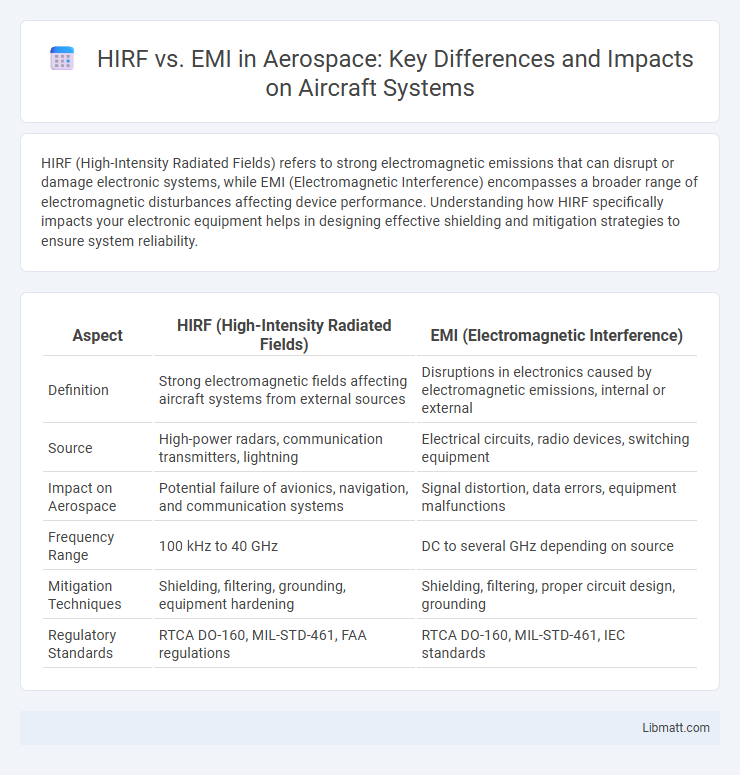HIRF (High-Intensity Radiated Fields) refers to strong electromagnetic emissions that can disrupt or damage electronic systems, while EMI (Electromagnetic Interference) encompasses a broader range of electromagnetic disturbances affecting device performance. Understanding how HIRF specifically impacts your electronic equipment helps in designing effective shielding and mitigation strategies to ensure system reliability.
Table of Comparison
| Aspect | HIRF (High-Intensity Radiated Fields) | EMI (Electromagnetic Interference) |
|---|---|---|
| Definition | Strong electromagnetic fields affecting aircraft systems from external sources | Disruptions in electronics caused by electromagnetic emissions, internal or external |
| Source | High-power radars, communication transmitters, lightning | Electrical circuits, radio devices, switching equipment |
| Impact on Aerospace | Potential failure of avionics, navigation, and communication systems | Signal distortion, data errors, equipment malfunctions |
| Frequency Range | 100 kHz to 40 GHz | DC to several GHz depending on source |
| Mitigation Techniques | Shielding, filtering, grounding, equipment hardening | Shielding, filtering, proper circuit design, grounding |
| Regulatory Standards | RTCA DO-160, MIL-STD-461, FAA regulations | RTCA DO-160, MIL-STD-461, IEC standards |
Introduction to HIRF and EMI
HIRF (High-Intensity Radiated Fields) and EMI (Electromagnetic Interference) are critical factors in electromagnetic compatibility studies, where HIRF refers specifically to high-power radio frequency emissions affecting electronic systems, typically in aerospace environments. EMI encompasses a broader spectrum of electromagnetic disturbances that degrade the performance of electrical circuits due to emitted or induced electromagnetic energy. Both HIRF and EMI require rigorous testing and mitigation to ensure the reliability and safety of sensitive electronic equipment.
Definitions: What Are HIRF and EMI?
HIRF (High-Intensity Radiated Fields) refers to strong electromagnetic fields typically generated by high-power radio frequency transmitters that can interfere with the operation of electronic systems. EMI (Electromagnetic Interference) encompasses a broader range of electromagnetic disturbances caused by various sources, including HIRF, which disrupt the normal functioning of electronic devices. Understanding the distinction between HIRF as a specific high-power subset and EMI as a general phenomenon is crucial for effective electromagnetic compatibility (EMC) management.
Key Differences Between HIRF and EMI
HIRF (High-Intensity Radiated Fields) primarily refers to intense radio-frequency electromagnetic fields that can disrupt or damage electronic systems, especially in aerospace applications. EMI (Electromagnetic Interference) encompasses a broader range of disturbances caused by electromagnetic radiation, affecting electronic devices and communication systems across various environments. Understanding the distinction helps you design better shielding and compliance strategies tailored to the specific nature and intensity of the interference.
Sources and Causes of HIRF
High-Intensity Radiated Fields (HIRF) originate primarily from powerful radio frequency transmitters, radar systems, and electromagnetic pulse events, emitting intense electromagnetic energy that can interfere with electronic equipment. The main causes of HIRF include military radar installations, aircraft communication transmitters, and high-powered broadcasting stations, which generate intense electromagnetic fields that can induce voltages and currents in nearby circuits. Unlike electromagnetic interference (EMI), which often arises from lower power or internal device sources, HIRF involves high-power external radiated emissions capable of disrupting or damaging sensitive electronic systems.
Sources and Causes of EMI
Electromagnetic Interference (EMI) primarily originates from both natural sources, like lightning and solar flares, and man-made sources, including switching power supplies, radio transmitters, and electronic circuits. High-Intensity Radiated Fields (HIRF) specifically refer to strong electromagnetic fields generated by aircraft systems, radar transmitters, and high-power RF equipment that can induce disturbances in avionics. While EMI encompasses a broad range of electromagnetic disturbances, HIRF sources are characterized by their intense radiated energy capable of causing significant disruptions in sensitive electronic components.
Effects of HIRF on Electronic Systems
High-Intensity Radiated Fields (HIRF) can induce unwanted voltages and currents in electronic systems, leading to malfunctions, data corruption, or permanent damage. Unlike Electromagnetic Interference (EMI), which generally refers to lower-intensity disturbances, HIRF represents extreme electromagnetic energy levels that stress system shielding and circuit robustness. Compliance with HIRF standards ensures electronic devices can maintain operational integrity in high-radiation environments such as aerospace or military applications.
Effects of EMI on Electronic Devices
Electromagnetic Interference (EMI) disrupts the normal operation of electronic devices by causing signal distortion, data loss, and functional errors. Electronic systems exposed to EMI may experience reduced performance, malfunction, or complete failure, particularly in sensitive components like microprocessors and communication modules. Unlike High-Intensity Radiated Fields (HIRF), which primarily affect aircraft systems with high powered RF energy, EMI impacts a broader range of consumer and industrial electronics with varying frequency emissions.
Regulatory Standards for HIRF and EMI
Regulatory standards for High-Intensity Radiated Fields (HIRF) are primarily defined by the Federal Aviation Administration (FAA) and the European Union Aviation Safety Agency (EASA), emphasizing protection of avionics from strong electromagnetic fields encountered during flight. Electromagnetic Interference (EMI) regulations focus on limiting emissions and susceptibility levels based on standards such as RTCA DO-160 and MIL-STD-461 to ensure electronic device integrity and safety. Compliance with these standards ensures that aircraft systems maintain functionality and reliability in environments with diverse electromagnetic disturbances.
Mitigation Techniques for HIRF and EMI
Mitigation techniques for High-Intensity Radiated Fields (HIRF) primarily involve shielding, filtering, and grounding to protect sensitive electronics from intense electromagnetic interference, ensuring system reliability. Electromagnetic Interference (EMI) mitigation focuses on controlling emissions through proper circuit design, use of ferrite beads, and maintaining signal integrity with careful PCB layout. Your electronic systems can achieve optimal performance by integrating these targeted HIRF and EMI mitigation strategies tailored to their specific operational environments.
Future Trends in HIRF and EMI Protection
Advancements in HIRF (High-Intensity Radiated Fields) and EMI (Electromagnetic Interference) protection emphasize adaptive shielding materials and AI-driven monitoring systems to counter increasingly complex electromagnetic environments. Innovations such as metamaterials and nanotechnology enhance the effectiveness of EMI filters and HIRF enclosures, ensuring your electronic systems maintain integrity under stringent aerospace and defense conditions. Emerging standards and simulation tools drive future-proof designs, reducing susceptibility to evolving electromagnetic threats.
HIRF vs EMI Infographic

 libmatt.com
libmatt.com